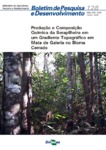Use este identificador para citar ou linkar para este item:
http://www.infoteca.cnptia.embrapa.br/infoteca/handle/doc/569203| Título: | Produção e composição química da serrapilheira em um gradiente topográfico em mata de galeria no bioma cerrado. |
| Autoria: | PARRON, L. M.  BUSTAMANTE, M. M. da C.   PRADO, C. L. C.   |
| Ano de publicação: | 2004 |
| Referência: | Planaltina, DF: Embrapa Cerrados, 2004. |
| Páginas: | 23 p. |
| Conteúdo: | RESUMO: Em função do gradiente de umidade na topografia do terreno e de diferenças entre estações seca e chuvosa, o presente trabalho teve como objetivos quantificar a produção anual e a disponibilidade de nutrientes (N, P, K, Ca, Mg E S) na serapilheira e estimar a eficiência do uso de nutrientes em uma Mata de Galeria. O experimento foi estabelecido numa área de 100 x 100 m da Mata de Galeria do Córrego Pitoco, na Reserva Ecológica do IBGE, DF (15°56'41"S e 47°56'07"W). Como delineamento experimental, foram estabelecidas três linhas de amostragem paralelas ao córrego, distantes 45 m entre si, denominadas, respectivamente, comunidades úmida (na margem do córrego), intermediárias e seca (adjacentes a uma área de Cerrado Típico). A produção de serapilheira que ocorre principalmente na estação seca, entre junho e setembro, foi 6,1; 7,2 e 7,0 t ha-1 ano-1, respectivamente, nas comunidades úmida, intermediária e seca, a biomassa de folhas foi 70% do total. As concentrações e os estoques de nutrientes na serapilheira foliar apresentaram-se na ordem N > Ca > K > S > P. As concentrações de N, P e S foram significativamente maiores na comunidade intermediária, e as de Km Ca, Mg, na seca. Na comunidade úmida, onde a umidade do solo é maior, a eficiência do uso de K, Ca, Mg e S pelas plantas também é superior em relação à seca. Em contraste, na comunidade seca, onde há restrição hídrica na estação seca, a eficiência do uso de N e P é maior. ABSTRACT: Considering the moisture variation along the topographical gradient and the differences between dry and rainy seasons, the present study had as objectives to quantify the annual litterfall production, to determinate the nutrients availability (N,P,K,Ca, Mg and S) in litterfall and to estimate the nutrient use efficiency for the Gallery Forest ecosystem. The experiment was established in a plot of 100x100m in the Gallery Forest of the Pitoco stream, in the Ecological Reserve of IBGE, Federal District, Brazil (15o56'41"S and 47o56'07"W). As experimental design, three sampling lines were established parallel to the stream, 45m distant to each other. The lines were denominated wet community (near the stream), intermediate community and dry community (adjacent to a typical Cerrado area). The litterfall production that occurs mainly in dry season, between June and September was, 6.1,7.2 and 7.0 ha (elevado a -1) y (elevado a -1), in wet, intermediate and dry communities and the leaves biomass was 70% of total. The nutrients concentration in litterfall were in the order N>Ca>Mg>K>S>P. The N, P and S concentrations were significantly higher in intermediate community and the K, Ca and Mg concentrations, in dry community. In wet community, where the soil moisture is higher, the use efficiency for K, Ca, Mg and S is higher than dry community. In opposite, in dry community, where there is water stress in the dry season, the use efficiency for N and P is superior. |
| Thesagro: | Disponibilidade de Nutriente Floresta Tropical Produtividade |
| NAL Thesaurus: | biogeochemistry tropical forests savannas |
| Palavras-chave: | Biogeoquímica Ciclagem de nutriente Eficiência de nutriente Savana Productivity Nutrient cycling Litterfall Nutrient efficiency |
| Série: | (Embrapa Cerrados. Boletim de Pesquisa e Desenvolvimento, 128) |
| Tipo do Material: | Folhetos |
| Acesso: | openAccess |
| Aparece nas coleções: | Boletim de Pesquisa e Desenvolvimento (CPAC)  |
Arquivos associados a este item:
| Arquivo | Descrição | Tamanho | Formato | |
|---|---|---|---|---|
| bolpd128.pdf | 1,02 MB | Adobe PDF |  Visualizar/Abrir |









